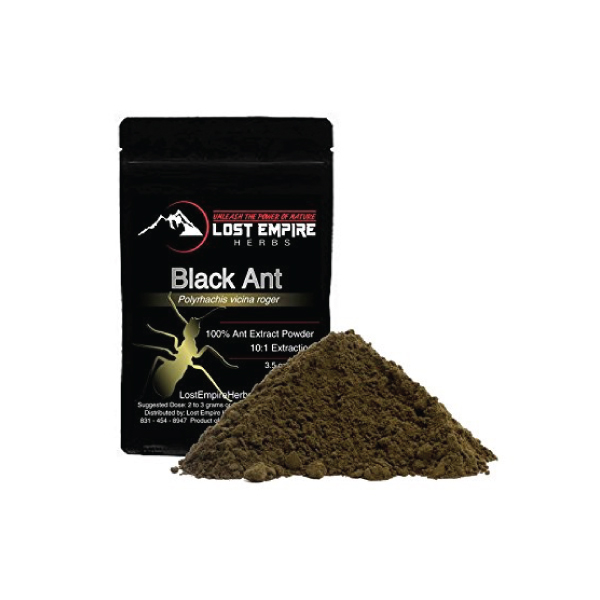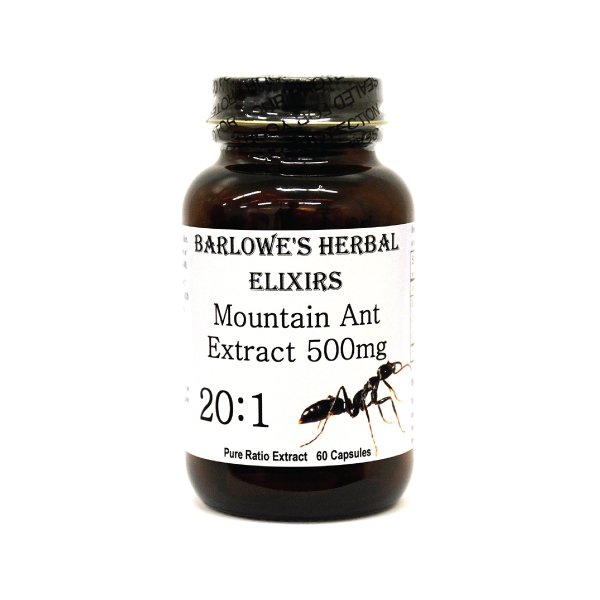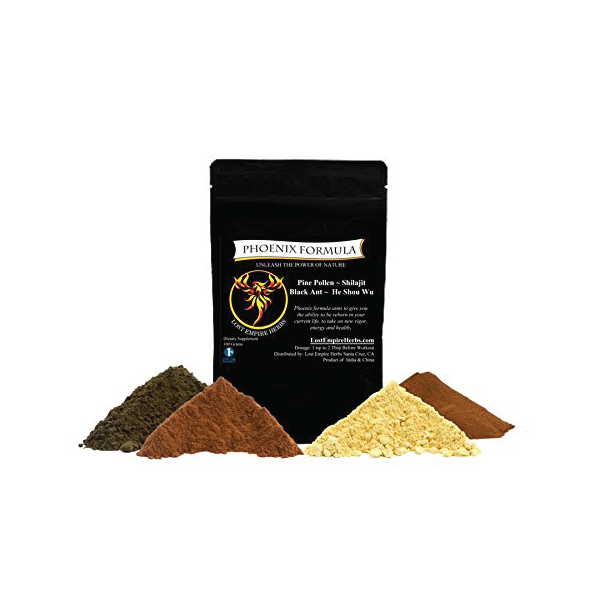What is Black Ant?
Black ant is exactly as it sounds... black ants. They contain a rich source of zinc, and other trace minerals, and provide a potent dose of protein. They are low in fat and carbohydrates, and contain a fibre known as chitin. As a nutritional supplement black ants are perfect for the body builder or athlete. The zinc, complete protein, and high fiber makes them one of the most well rounded protein sources available.
Aside from the nutritional value, black ants have a few key medicinal actions as well. They contain a growth hormone known as ecdysterone, which has been shown to have mild anabolic steroid activity in humans. This opens the floor to black ants use to a wide number of conditions, especially when combined with the rich source of protein, zinc, and trace minerals needed to grow and repair muscles.
In Chinese medicine where its use is most popular, black ant is used as a cognitive enhancer for students, to promote the repair of broken or damaged bone and muscle tissue, as an athletic performance enhancer, and to treat sexual dysfunctions in both men and women.
Consuming black ant is easy, as it can be taken as a powder in a smoothie or protein shake, made into backed goods, capsulated, or taken as a liquid extract.
Featured Black Ant Products
What Is Black Ant Used For?
Black ant is mainly used as an athletic performance enhancer as an addition to the supplementing regimen. It is also popular amongst students looking to increase their cognitive endurance for long hours of study.
The nutritional content of black ant, especially the protein and zinc make it useful for a wide range of conditions from a nutritional standpoint, including anemia, poor immune function, malnutrition, and weak sexual function.
Traditional Uses of Black Ant
In places like Taiwan, Hong Kong, and Shanghai, where this supplement is very popular, it is sold in many health clubs as a pre-workout elixir. Students in these areas also commonly consume this to prevent burnout from a busy workload, and to improve their concentration.
+ Traditional Chinese Medicine
In traditional Chinese medicine, black ant is considered a premier Qi tonic, considered by some to be even more powerful than the highly esteemed Ginseng. It is considered an adaptogen and is in the same class of “superstar” Chinese tonics as Eleuthero (Siberian ginseng), cordyceps, reishi (Ganoderma), and schizandra (Teeguarden, 1998).
A Note on Consuming Insects
Consuming insects as food or medicine is not a new concept, and likely predates human history. Fortunately in modern times we have the ability to extract the desired constituents from these insects in either a liquid extract, or powder form where it can then be encapsulated, added to smoothies, or baked with. In this way we can consume bugs, without having to actually eat them.
Details: Black Ant
Herbal Actions:
- Nutritive
- immunomodulator
- Mild CNS Stimulant
- Mild anabolic steroid
- Male Tonic
Weekly Dose
- (10:1 Liquid Extract)
10-50 mL - View Dosage Chart
Part Used
Whole ant body
Family Name
Formicidae
Distribution
Mountainous Regions of China
Islands of Southeast Asia and The South Pacific
Mountainous regions of Australia
Constituents of Interest
- Ecdysterone
- Vitamins
- Minerals
- Amino acids
Common Names
- Black ant
- Polyrhachis
- Hei Ma Yi (China)
CYP450
- Unknown
Quality
- Warm
Pregnancy
- Unknown
Taste
- Unknown
Duration of Use
- Long term use acceptable.
Products Containing Black Ant
Entomological Info:
Polyrhachis as a genus contains 697 species. Although only Polyrhachis vicina has been thoroughly studied, it is likely that many of these other species contain very similar compounds.
Pharmacology & Medical Research:
+ Athletic Enhancement
Your muscles need zinc for muscle contraction to occur, and for the cells to divide and grow (resulting in muscle growth). This is how the high levels of zinc contained in black ant contribute to the beneficial effects on power in the human body.
Ecdysterone is an insect hormone contained in high amounts in black ant, and even in some plants. It is structurally very similar to androgens, and some suggest its use as a safer alternative to anabolic steroids. More study is needed to determine the effectiveness of this compound, however.
Black ants are actually an ideal supplement for athletes and are recommended to be consumed with other athletic tonics such as suma, maca,
Taking this “herb” (used in this context to describe a medicinal compound from nature) before a workout, will deliver the best results. The effects are generally felt relatively quickly, and build over time. Another great use is as a tonic during times of particular weakness, or for the very old or very young to generate strength, or to increase sexual activity in those with low sex drive.
+ Immune Function
We can also relate at least some of the positive effects ants have on the immune system to the zinc content. Chinese medicine has used ants for this purpose for a long time and considers it to have bi-directional activity. Meaning it can both improve a poor immune system and dial back an over productive one (as in the case of autoimmune disorders), making this an extremely valuable (and safe) tonic for the immune system.
+ Sexual Function
The high nutritional content of zinc is also partly responsible for black ants effects on improving sexual potency. Zinc is an essential mineral in a variety of sexual functions from spermatogenesis, to the formation of an erection.
Chemical Constituents of Black Ant
The nutritional content of black ant is quite impressive, containing between 42% and 67% protein of total weight, and only 10% fat content. On top of this, black ant contains high amounts of chitin, which is am insoluble fibre found in the exoskeletons of insects as well as in fungi.
The amino acid content in black ants is also impressive, with the limiting amino acids being methionine, and cysteine. Phenylalanine, tyrosine, and tryptophan are all contained in high amounts in black ant. These amino acids all are used as precursors to various neurotransmitters in the brain and throughout the body, it is important to have a healthy dose of these amino acids in order to maintain healthy levels of these neurotransmitters. This may play a role in some of black ants effects in combatting low libido, improving sexual health, and enhancing athletic performance.
Black ant also contains high amounts of the minerals calcium, zinc, magnesium, and manganese, and also includes potassium, phosphorous, iron, selenium, chromium, and sodium.
Vitamins included in black ant are B1, B2, B12, D, and E. On top of this, black ant contains high amounts of the steroid ecdscerone. This compound has been the study of a lot of recent research for its growth stimulating effects.

Clinical Applications Of Black Ant:
Black ant is very useful as an athletic enhancement supplement, and for treating damaged bone and muscle. Its nutritional content makes it useful for blood deficiencies like some anemias, poor immune function (low WBC), and low albumin levels. it is also useful for sexual dysfunction of various sources, and symptoms of malnutrition.
Cautions:
Black ant is reported to have a mild stimulating nature. If sleeping difficulty is experienced, take black ant earlier in the day or cease use.
Synergy
In the Chinese medical system, black ant is thought to have synergy with ginseng and codonopsis as a powerful Qi tonic.
Recent Blog Posts:
References:
A Modern Herbal | Cacao. (n.d.). Retrieved from https://www.botanical.com/botanical/mgmh/c/cacao-02.html
E. O Afoakwa, E. Ofosu-Ansah, A. S. Budu, H. Mensah-Brown, J. F. Takrama. (2015). Roasting Effects on Phenolic content and Free-Radical Scavenging Activities of Pulp Pre-Conditioned and Fermented cocoa (Theobroma cacao) Beans. African Journal of Food, Agriculture, Nutrition and Development. Vol 15. No, 1.
Erika B. Laconi and Anuraga Jayanegara. (2015). Improving Nutritional Quality of Cocoa Pod (Theobroma cacao) through Chemical and Biological Treatments for Ruminant Feeding: In vitro and In vivo Evaluation. Asian Australas. J. Anim. Sci. Vol. 28, No. 3 : 343-350
FastStats - Leading Causes of Death. (Aug 21 2015). Retrieved September 26, 2015, from http://www.cdc.gov/nchs/fastats/leading-causes-of-death.htm
Franzen, M., & Mulder, M. B. (2007). Ecological, economic and social perspectives on cocoa production worldwide. Biodiversity and Conservation, 16(13). doi:10.1007/s10531-007-9183-5
Ganiyu Oboh, Ayokunle O. Ademosun, Adedayo O. Ademiluyi, Olasunkanmi S. Omojokun, Esther E. Nwanna, and Kuburat O. Longe. (2014). In Vitro Studies on the Antioxidant Property and Inhibition of 𝛼-Amylase, 𝛼-Glucosidase, and Angiotensin I-Converting Enzyme by Polyphenol-Rich Extracts from Cocoa (Theobroma cacao) Bean. Pathology Research International. http://dx.doi.org/10.1155/2014/549287
Giovanni Scapagnini, Sergio Davinelli, Laura Di Renzo, Antonino De Lorenzo, Hector Hugo Olarte, Giuseppe Micali, Arrigo F. Cicero and Salvador Gonzalez. (2014). Cocoa Bioactive Compounds: Significance and Potential for the Maintenance of Skin Health. Nutrients. 6. 3202-3213. doi:10.3390/nu6083202
John S. Henderson, Rosemary A. Joyce, Gretchen R. Hall, W. Jeffrey Hurst, and Patrick E. McGovern. (2007). Chemical and archaeological evidence for the earliest cacao beverages. PNAS.vol 104. 18937-18940
Kathrin Becker, Simon Geisler, Florian Ueberall, Dietmar Fuchs and Johanna M. Gostner. (2013). Immunomodulatory properties of cacao extracts - potential consequences for medical applications. Frontiers in Pharmacology. vol 4. Article 154. doi: 10.3389/fphar.2013.00154
Yeyi Gu, William J. Hurst, David A. Stuart, and Joshua D. Lambert. (2011). Inhibition of Key Digestive Enzymes by Cocoa Extracts 1 and Procyanidins. J Agric Food Chem. 5305-531. doi:10.1021/jf200180n.
Zainal Baharum, Abdah Md Akim, Yun Hin Taufiq-Yap, Roslida Abdul Hamid and Rosmin Kasran. (2014). In Vitro Antioxidant and Antiproliferative Activities of Methanolic Plant Part Extracts of Theobroma cacao. Molecules. 19. 18317-18331 doi:10.3390/molecules191118317 Retrieved from the web.

















As COVID-19 continues to spread around the world, we’re getting a lot of questions on what the potential role of herbal medicine is during the outbreak. Learn how the virus works and how to limit your chances of transmission.